 Lots of gardeners in my zone has a love affair going on with hydrangeas. As well they should. They are rangy growing shrubs that deliver a heart stopping show of big luscious blooms from early to late summer, provided they get some regular water, and a decent amount of sun. It is that easy to have a spectacular show of flowers in the landscape in late summer. Even the fall color on the blooms is good.The Annabelles start blooming in June, and are followed up on into August with cultivars big and small – too numerous to list or review. Every season seems to bring a new collection of hydrangea cultivars to market. It is easy to understand why. They give a lot, and do not ask for much. The oak leaf hydrangeas are equally stunning both in leaf and in bloom, and are incredibly shade tolerant. Our hydrangea season is late this year. Think back to that April we had that was snowy and cold the entire month – you get the picture. My overgrown Limelight hydrangeas needed a strong pruning this spring. I could not tell now that they had been pruned down to 14″ above grade. They are blooming lavishly. They make me look like an expert gardener. In spite of what I do or do not do, they thrive.
Lots of gardeners in my zone has a love affair going on with hydrangeas. As well they should. They are rangy growing shrubs that deliver a heart stopping show of big luscious blooms from early to late summer, provided they get some regular water, and a decent amount of sun. It is that easy to have a spectacular show of flowers in the landscape in late summer. Even the fall color on the blooms is good.The Annabelles start blooming in June, and are followed up on into August with cultivars big and small – too numerous to list or review. Every season seems to bring a new collection of hydrangea cultivars to market. It is easy to understand why. They give a lot, and do not ask for much. The oak leaf hydrangeas are equally stunning both in leaf and in bloom, and are incredibly shade tolerant. Our hydrangea season is late this year. Think back to that April we had that was snowy and cold the entire month – you get the picture. My overgrown Limelight hydrangeas needed a strong pruning this spring. I could not tell now that they had been pruned down to 14″ above grade. They are blooming lavishly. They make me look like an expert gardener. In spite of what I do or do not do, they thrive.
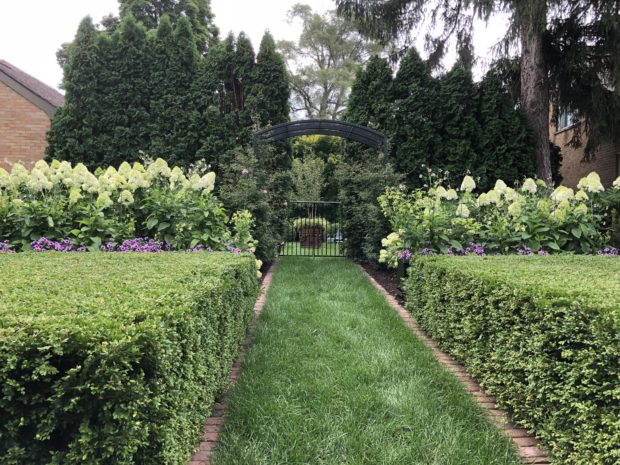 Hydrangeas are easy to grow, but they can be difficult to site in the landscape. They are big growing show offs that don’t naturally play well with neighboring plants. A single Limelight hydrangea can grow easily to 7 feet tall, and 7 feet wide. Even the smaller growing cultivars have giant flowers. They can easily become the elephant in the room-impossible to ignore. It takes some thought to integrate them into a garden, or a landscape. I am not so much a fan of their woody legs, so I try to place them where that bottom third of the plant is not so much a part of the overall view. I also favor planting blocks of them, meaning I like lots of them as opposed to planting a single plant. They want to be the star of the summer garden, so why not let them show off? Masses of summer blooming hydrangeas speak to summer in the Michigan garden in a way that no other plant does.
Hydrangeas are easy to grow, but they can be difficult to site in the landscape. They are big growing show offs that don’t naturally play well with neighboring plants. A single Limelight hydrangea can grow easily to 7 feet tall, and 7 feet wide. Even the smaller growing cultivars have giant flowers. They can easily become the elephant in the room-impossible to ignore. It takes some thought to integrate them into a garden, or a landscape. I am not so much a fan of their woody legs, so I try to place them where that bottom third of the plant is not so much a part of the overall view. I also favor planting blocks of them, meaning I like lots of them as opposed to planting a single plant. They want to be the star of the summer garden, so why not let them show off? Masses of summer blooming hydrangeas speak to summer in the Michigan garden in a way that no other plant does.
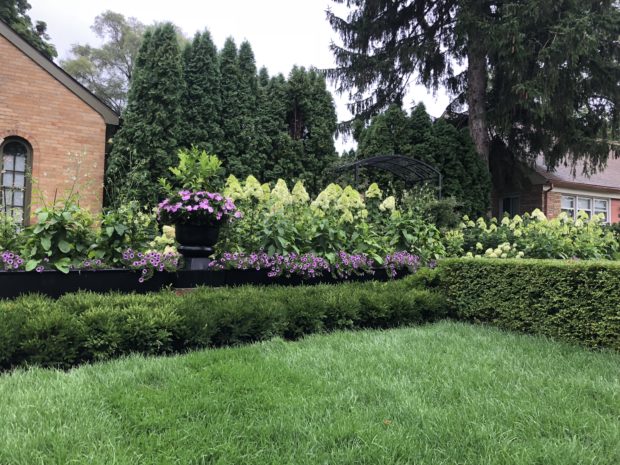 My limelight hydrangeas at home have a long bank of planter boxes placed in front of them. Those boxes are planted with nicotiana alata lime, and nicotiana mutabilis. The boxes hide those long woody hydrangea stems coming out of the ground. The delicate airy mass of nicotiana flowers interact in a contrasting way with those giant hydrangea blooms. The hydrangea flower backdrop makes it easier to see the nicotiana from a distance.
My limelight hydrangeas at home have a long bank of planter boxes placed in front of them. Those boxes are planted with nicotiana alata lime, and nicotiana mutabilis. The boxes hide those long woody hydrangea stems coming out of the ground. The delicate airy mass of nicotiana flowers interact in a contrasting way with those giant hydrangea blooms. The hydrangea flower backdrop makes it easier to see the nicotiana from a distance.
 The foliage of the nicotiana repeats the big leaves of the hydrangea. The large leaves are a good foil for the diminutive boxwood foliage. The simple mass of boxwood sets the stage for a late summer. Nothing can rival the excitement generated in the spring as the landscape roars back to life, but I look forward to this late summer display. On a 90 degree August day, this looks fresh and inviting. The hydrangeas are part of a story.
The foliage of the nicotiana repeats the big leaves of the hydrangea. The large leaves are a good foil for the diminutive boxwood foliage. The simple mass of boxwood sets the stage for a late summer. Nothing can rival the excitement generated in the spring as the landscape roars back to life, but I look forward to this late summer display. On a 90 degree August day, this looks fresh and inviting. The hydrangeas are part of a story.
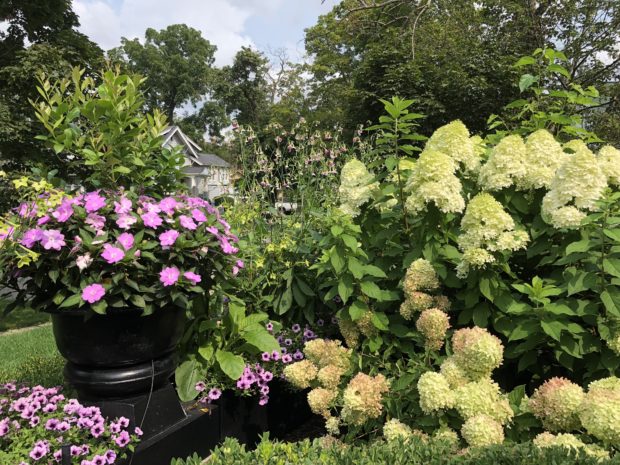 As a designer, I have a concern about about how spaces come together, and read. Shrubs, perennials,annual plants, and containers have their contribution to make. The design issue is making sure all the various voices work together in some way. The green leaves of the Persian Lime in the center of the pot helps to balance the green of the hydrangea foliage. The big growing hydrangeas need some equally strong minded company. I did face down my limelight hydrangeas with an outside row of Little Limes. Was that a good idea? It is too soon to tell, as the Limelights were very hard pruned this spring, so they have fewer and larger flowers this year. This is only the second season for the Little Limes, so they are not yet full sized. They are actually quite different in coloration than Limelight.
As a designer, I have a concern about about how spaces come together, and read. Shrubs, perennials,annual plants, and containers have their contribution to make. The design issue is making sure all the various voices work together in some way. The green leaves of the Persian Lime in the center of the pot helps to balance the green of the hydrangea foliage. The big growing hydrangeas need some equally strong minded company. I did face down my limelight hydrangeas with an outside row of Little Limes. Was that a good idea? It is too soon to tell, as the Limelights were very hard pruned this spring, so they have fewer and larger flowers this year. This is only the second season for the Little Limes, so they are not yet full sized. They are actually quite different in coloration than Limelight.
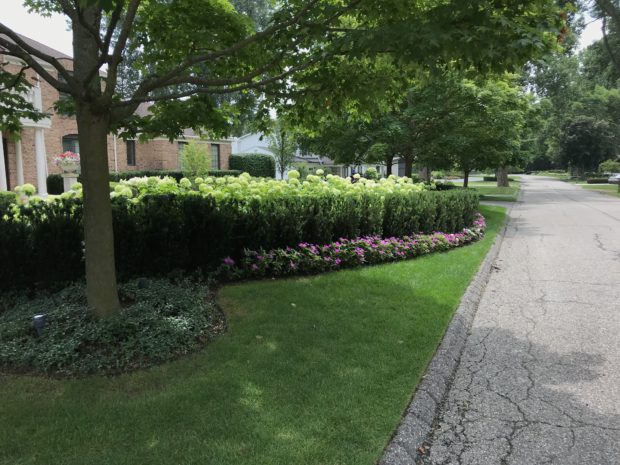 This landscape project from last year features a long sweeping curve of upright yews. All that is visible from the street of the Incrediball hydrangeas are the flowers. An annual planting at the base of the yews provides another layer of interest.
This landscape project from last year features a long sweeping curve of upright yews. All that is visible from the street of the Incrediball hydrangeas are the flowers. An annual planting at the base of the yews provides another layer of interest.
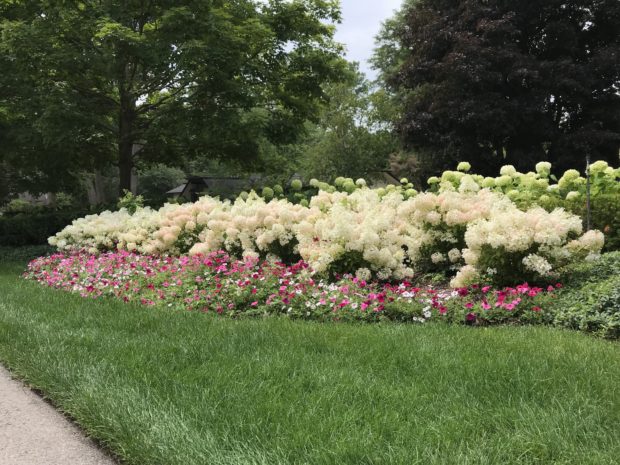 Inside the Incrediball hydrangea hedge is a mass of Bobo hydrangea, also faced down with flowers. All those woody stems and leaves are sandwiched in between plants that reveal the best part of these big growing plants, and obscures the least interesting. Hydrangea Bobo is the smallest growing of this series, which means it is the easiest of the three to place. It is perfectly scaled at 3′-5′ tall for smaller gardens. Small spaces can easily be overwhelmed by big growing hydrangeas.
Inside the Incrediball hydrangea hedge is a mass of Bobo hydrangea, also faced down with flowers. All those woody stems and leaves are sandwiched in between plants that reveal the best part of these big growing plants, and obscures the least interesting. Hydrangea Bobo is the smallest growing of this series, which means it is the easiest of the three to place. It is perfectly scaled at 3′-5′ tall for smaller gardens. Small spaces can easily be overwhelmed by big growing hydrangeas.
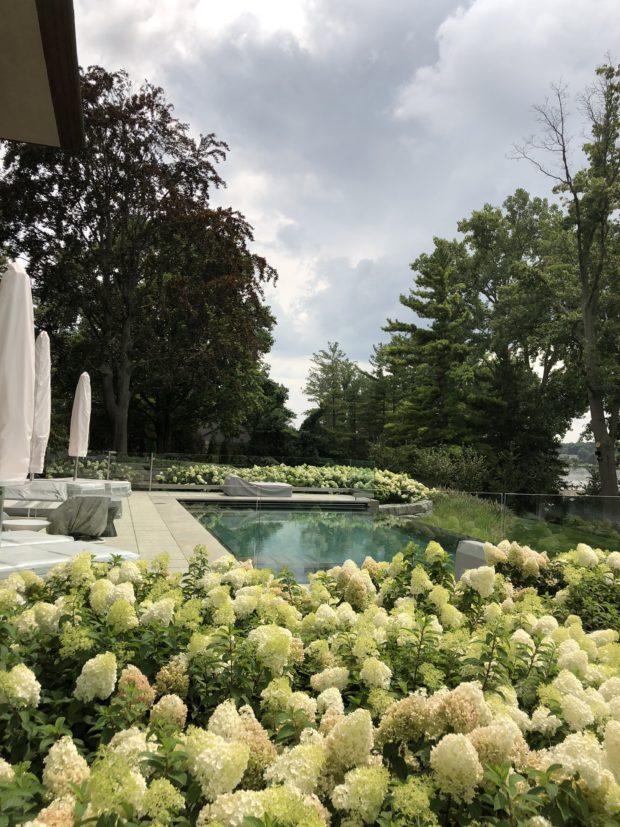 We planted several large masses of these on either side of a pool. The creamy green color of the flowers contrasts dramatically with the color of the water. This hydrangea grows large enough to just obscure the fact that the bed was originally terraced into two levels with large informally placed slabs of stone.
We planted several large masses of these on either side of a pool. The creamy green color of the flowers contrasts dramatically with the color of the water. This hydrangea grows large enough to just obscure the fact that the bed was originally terraced into two levels with large informally placed slabs of stone.
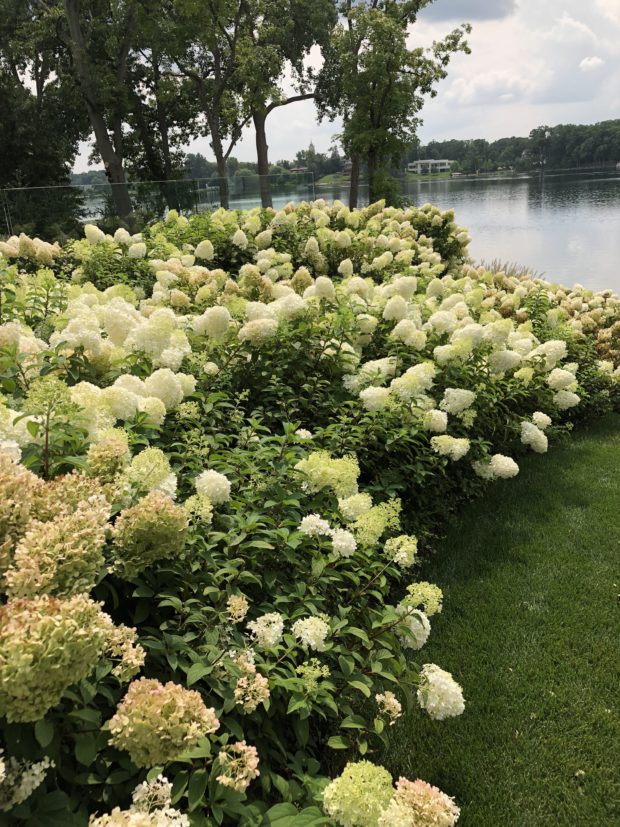 Though the grade does drop considerably and quickly from the pool to the water, the mass of low growing hydrangeas helps to soften the descent. The transition from the pool level to the lake level happens fast. The hydrangeas provide a reason to slow down, and linger.
Though the grade does drop considerably and quickly from the pool to the water, the mass of low growing hydrangeas helps to soften the descent. The transition from the pool level to the lake level happens fast. The hydrangeas provide a reason to slow down, and linger.
 The view of these hydrangeas, filtered with tall later blooming perennials and annuals, is a soft and informal look. Hydrangeas are stiff and static growing, and benefit from some airy companionship. Phlox have that same stiff habit of growth. In this arrangement, the phlox looks so much more relaxed, given a static growing plant that is so much larger growing.
The view of these hydrangeas, filtered with tall later blooming perennials and annuals, is a soft and informal look. Hydrangeas are stiff and static growing, and benefit from some airy companionship. Phlox have that same stiff habit of growth. In this arrangement, the phlox looks so much more relaxed, given a static growing plant that is so much larger growing.
 There are those places where a single hydrangea can make a statement. This tree hydrangea, one of a pair, spends the winter in my landscape building, in a big plastic pot. In the spring, it is pruned, both on the top, and the roots, and planted back into this large box. A second pruning a month or six weeks later helps to provide a network of strong branches which will help support the blooms. The box is large enough to permit an under planting of euphorbia, petunias and variegated licorice. Seeing it yesterday for the first time since it was potted up in May was a treat. Part formal and part exuberant, it is everything a well grown hydrangea can be.
There are those places where a single hydrangea can make a statement. This tree hydrangea, one of a pair, spends the winter in my landscape building, in a big plastic pot. In the spring, it is pruned, both on the top, and the roots, and planted back into this large box. A second pruning a month or six weeks later helps to provide a network of strong branches which will help support the blooms. The box is large enough to permit an under planting of euphorbia, petunias and variegated licorice. Seeing it yesterday for the first time since it was potted up in May was a treat. Part formal and part exuberant, it is everything a well grown hydrangea can be.
thank you for giving me a lot to think about in my own landscape and the information helps me appreciate the landscapes of others. That last hydrangea in the pot reminded me of the famous theatrical plant Audrey , saying “Feed me!!!!”
Great post, Deborah. I love hydrangeas and plan to incorporate them into our landscaping one day. This gave me some ideas of how to do it. ~Miranda
Your hydrangeas are astonishing. Here in California they seem to require some shade? And the ones in my garden are suffering from something, either not enough water, too much sun, or a disease, I haven’t figured it out. The leaves appear to burn, at the edges, and then in patches closer to the stem. They turn reddish too. Do you have any insight into hydrangea diseases? I’ve looked online, seems it could be anthracnose or cercospora, but the pictures don’t quite match what I see, hence my wondering if it’s lack of water (we get no rain, I water by hand with a spray hose every other day.)
I know you are not here to answer our detailed gardening questions per se:), just thought if people are encouraged to plant them, love them as I do, a brief discussion of diseases could be warranted? If not, please just ignore me and I’ll keep fumbling around trying to sort it out here!
Dear Lisa, I have no idea what could be wrong. I have no idea about gardening in California. Do you have a local agricultural extension agent? Maybe it would help to soak the root balls at the base of the plant with a soaker hose or small daisy sprinkler set very low. My hydrangeas will get brown on the leaf edges and tips of the petals when they are too dry. best, Deborah
You introduced me to hydrangeas years ago and my garden has never been the same, it’s alive with hydrangeas now!
Dear Alicia, good to read this. They are satisfying to grow. best, Deborah
You have been Limelight’s well deserved champion! I’ve benefited greatly from your generously shared experience and fabulous photos!!!! Many thanx from a NOLA hydrangea fan!
Dear Libby-thank you! I do think they are beautiful in bloom. best, Deborah
Dear Libby, thank you! I do think they are beautiful in bloom. best, Deborah
New York State also loves hydrangeas…… and they are so easy peasy. I have never cut mine back — you mentioned pruning down to 14 inches —– why do that? Do they bush out even more?
Thanks !!
Dear Carol, my Limelights are pretty old, and had gotten leggy. I pruned them hard to rejuvenate them. They will be back to their bushy selves by this time next year. best, Deborah
I have limelight hydrangeas in front of my farm in Virginia. The flower heads are large and beautiful, but so heavy they fall over. Any suggestions on keeping the tall and heavy stems upright?
Thanks ~
Dear Pam, you could try pruning more lightly, so you have more flowers, but of a smaller size. Or super heavy gauge tall tomato cages can help-but you have to get those on the plants first thing in the spring. Once they have gone over, they are about impossible to sucessfully stake. best, Deborah
Deborah,
I understand your concept of underplanting to hide the legs. It would be helpful to see how these look in the fall, when the flowers turn brown and the annuals are gone.
Dear Christine, the hydrangeas in my garden have their legs hidden by planter boxes that are there all year round. In other places, I don’t mind the sticks so much. That’s what we have in late fall and winter-sticks everywhere. Perennials would die back as well as the annuals. Pairing hydrangeas with boxwood means there will be some green to be seen all year round. all the best, Deborah
I have a row of 10 ‘Endless Summer’ hydrangeas. They are sited in full sun and have received ample!! water with all the rain this summer. I have a total of 5 blooms on these shrubs. I can’t imagine what is wrong,since I thought ‘Endless Summer’ bloomed on old and new wood.
Dear Helen, Endless Summer blooms mostly on old wood. The flower buds can be killed by a cold winter. I wrote about this in another hydrangea post. Type into the blog search line Those Other Hydrangeas all the best, Deborah
Inside the Incrediball hydrangea hedge is a mass of Bobo hydrangea, also faced down with flowers… what are the flowers in front of this? I planted a Limelight hedge last spring that I am in love with, this would be a great addition. Thank you from TN!
Dear Deborah, they are a mix of vista petunias-nothing fancy. This client is fond of annual flowers for their long season of bloom. best, Deborah
Your mass hydrangea plantings are big statement shrubs. I love the way you hide the woody bottom of the plant. I’m thinking of adding more to my property. Thus far the deer have not bothered my hydrangeas; yet, I am told deer will go after them. This is the risk. Hence the delay in decision making I especially liked the hydrangea on either end of the pool. Absolutely breathtaking masses of flower. Are any hydrangeas deer proof?
. .
Dear Susan, I doubt that anything is deer proof. And yes, I have heard of deer eating hydrangeas, but I have never seen it. best, Deborah
Dear Deborah, I too love hydrangeas. So far I only have Annable ones. I have never fertilized them. What would you suggest.? Thank you. Lisa PS. You Are my inspiration.
Dear Lisa, I put some hollytone on them, when I remember! best regards, Deborah
Only one of our many Limelight hydrangeas has developed a problem this year. We live in upstate NY where this summer has been hot and rainy. In mid-July a mature sized Limelight began displaying many yellowing leaves which dropped off. Now, about a month later, many of the branches are leafless and the blooms on those branches have dried up, yet about half the shrub is leafy and blooming normally. I suspect the cause may be the roots may have remained too wet, for too long on this Limelight. We have 30 some others that are thriving. Your thoughts, please?
Dear Dick, your assessment sounds plausible. It is hard to imagine root rot on hydrangeas, but I suppose it is possible. But on only 1/2 the shrub? Any chance of physical damage to it? Is there anyone near you who could look at it? Sounds heartbreaking. best, Deborah
Beautiful! I keep cutting my Limelights back to 2′ or less and they come back gangbusters . . . . thinking now they are too large for their spot and going to move them . . . the flowers tumble over after a hard rain and don’t come back up. Question: what variety of nicotiana is planted in front of your home with the hydrangeas and the purple petunias?
Dear Michael, you could try pruning the top 12 inches off the top of all the branches. This would result in more flowers of a smaller size-and the flowers would not go over. Very hard pruning like this results in fewer flowers of enormous size. They would go over in a rain. If you are needing to cut them back this hard, then maybe the shrub is too big for the space. I would move them, and let them grow out.
I have used nicotiana alata lime, and nicotiana mutabilis. all the best, Deborah
When is a good time to move limelight hydrangeas.
Dear Tom, I have moved them at different times of the season, but I suspect April is good in my zone.best, Deborah
Oh Deborah, I can’t believe how sad looking my Bobo hydrangeas look compared to yours! My three Bobo’s only get morning sun. They don’t have many flowers and the flowers aren’t very big. They’re about five years old. I can only guess they’re not getting enough sun. Yours are stunning!
Very informative article! Absolutely love your designs! I planted two limelight hydrangea trees a year ago. This spring I pruned the branches to about 12 long. The tree looked beautiful until the 1st downpour in August… All of the branches have flopped down, with only a few of them sticking straight up, and some of them broke from the weight of the flowers. You mentioned pruning hydrangea trees in early spring, and then 4 to 6 weeks later. What do you do at the second pruning? Thank you in advance for your time responding!
Dear Natasha, prune lighter in April.Prune the branches to 16-20 long from the trunk. Then 6 weeks later, tip prune. This said, there is no formula for this. The idea is to not prune so severely all at once that you get overly long branches that break when the flower head is saturated with rain water. best, Deborah
Hi Deborah! I can never get enough of your limelight posts. You always provide a wealth of information. But even with everything I know, I have managed to over water my limelights.
They were just planted this year and with the extreme heat (Chicagoland) and not yet being established, I was loving them too much. The flowers are getting sad and crispy. Leaves have always been flagged down and are now turning yellow and dropping. I finally went and dug down deeper this evening to face the truth. The soil is very moist (can’t squeeze water out, though) and I pulled a few roots and was hoping they would rinse to white – but no. I plan to dig this up and rinse the root ball for a good look. If the root system is dark brown/black for the most part, is there any hope? Does it make a difference if the roots are dark but not smelly or slimy? Any thoughts are much appreciated. Thank you.
Dear Jennifer, hydrangeas can be tough to manage when they are first planted. They grow so fast that they rapidly become root bound in their pots. If that root ball dries out even for a short time, it can result in singed leaves and flowers. No amount of water will change that look.I would leave it be. The will to live is pretty strong. It may be fine in the spring. If the plant is stressed, digging it up and rinsing soil off the roots may just add another layer of stress. best, Deborah
I already loved hydrangeas but this post made me salivate! The photos of the plantings on either side of the pool are utterly gorgeous and the perennials, like the Nicotiana, amidst the heavier hydrangea is so perfect. Your work is always so wonderful.
HI! I am new to Limelight’s. We have them planted around our screened in porch. The 1st year they were perfect. The 2nd year, although I pruned them back earlier in the spring, they grew too large for me to handle. It was overwhelming for me they shot up so much – shocking. Earlier in the spring I had pruned them back to be maybe 2 feet tall. I also didn’t like the growth pattern that I’m guessing was to how I pruned it in the spring? The centers were shot straight up and I didn’t care for the shape around them at all. I need some serious Hydrangea help. I have to get out there and prune them soon and I just don’t know what to do. Can you please help me?! Thank you!
Dear Jessica, the short answer is to prune twice. To 30″ tall in early spring. And again the end of May. If they are still too tall in July, you need to choose a shorter growing cultivar for this location. best, Deborah